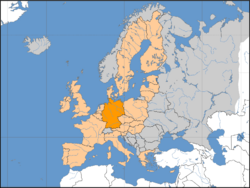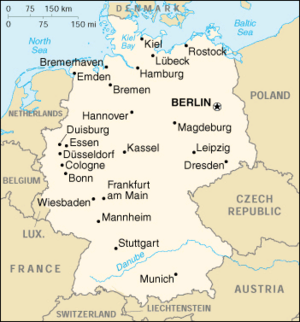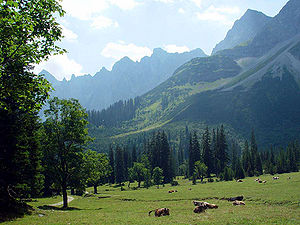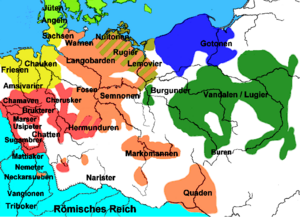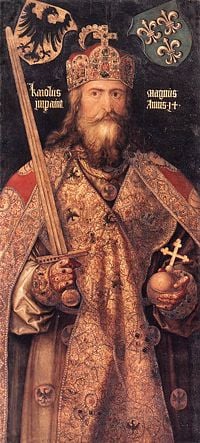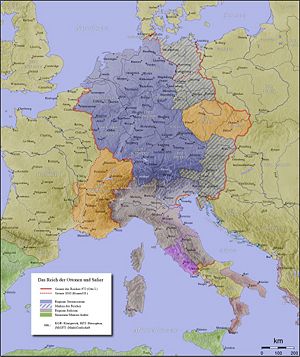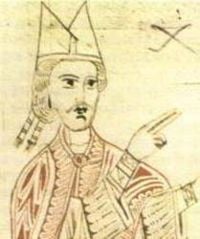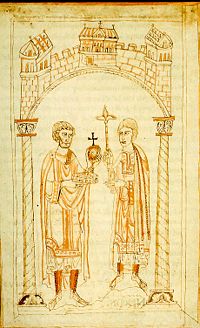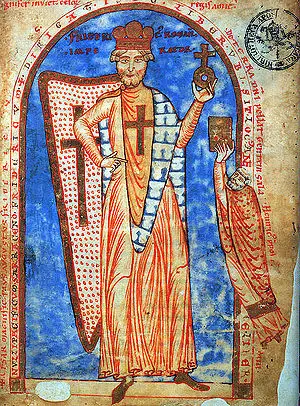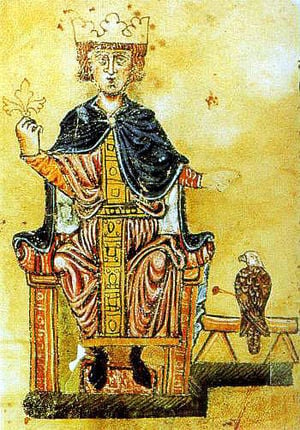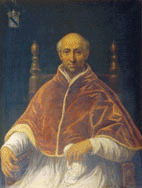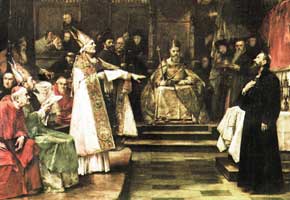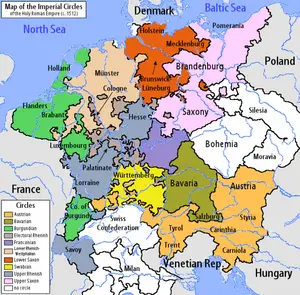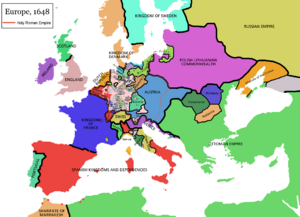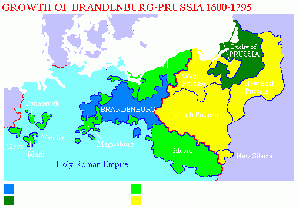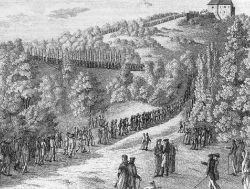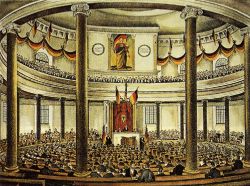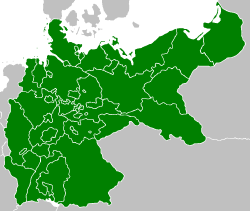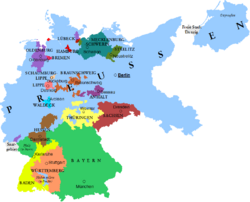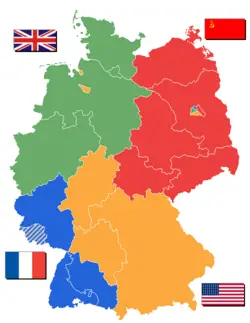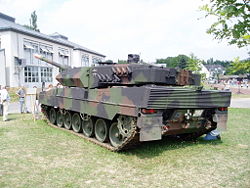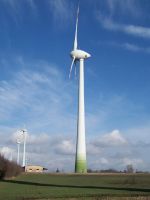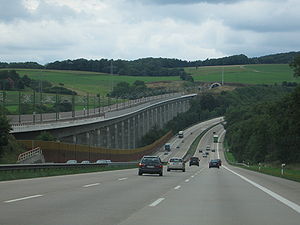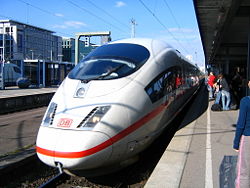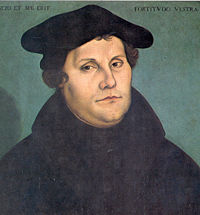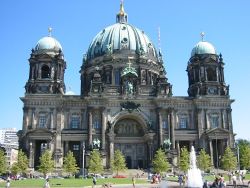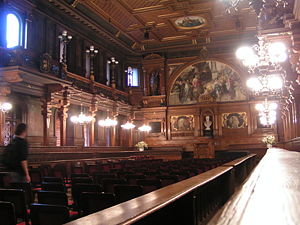Difference between revisions of "Germany" - New World Encyclopedia
Mike Butler (talk | contribs) |
Mike Butler (talk | contribs) |
||
| Line 252: | Line 252: | ||
The war ended with the [[Treaty of Mnster]], a part of the wider [[Peace of Westphalia]] in 1648. The treaty recognized the independence of each Holy Roman Empire state, making the Holy Roman Emperor powerless. The prince of each German state would determine its religion, meaning that Habsburg lands and those the south and west were Catholic. The treaty recognized the Reformed faith, and agreed Protestants could retain acquired lands. But Germany had lost about one-third of its population to war, famine, and plague, as well as much of its livestock, capital, and trade. Refugees and mercenaries roamed, seizing what they could. | The war ended with the [[Treaty of Mnster]], a part of the wider [[Peace of Westphalia]] in 1648. The treaty recognized the independence of each Holy Roman Empire state, making the Holy Roman Emperor powerless. The prince of each German state would determine its religion, meaning that Habsburg lands and those the south and west were Catholic. The treaty recognized the Reformed faith, and agreed Protestants could retain acquired lands. But Germany had lost about one-third of its population to war, famine, and plague, as well as much of its livestock, capital, and trade. Refugees and mercenaries roamed, seizing what they could. | ||
| − | ===The rise of | + | ===The rise of Prussia=== |
| − | [[ | + | [[Image:Acprussiamap2.gif|thumb|300px|left|After the Peace of Hubertsburg in 1763, Prussia became a European great power. The rivalry between Prussia and Austria for the leadership of Germany began.]] |
| + | From 1640, [[Brandenburg-Prussia]] had started to rise under the Great Elector of the House of [[Hohenzollern]], [[Frederick William, Elector of Brandenburg|Frederick William]] (1620-1688). The [[Peace of Westphalia]] in 1648 strengthened it even further, through the acquisition of East Pomerania. A system of rule based on [[Political absolutism|absolutism]] was established. In 1701, [[Frederick I of Prussia|Elector Frederick of Brandenburg]] was crowned "[[King in Prussia|King ''in'' Prussia]]". From 1713 to 1740, [[Frederick William I of Prussia|King Frederick William I]], also known as the "Soldier King", established a highly centralized state. | ||
| + | |||
| + | Meanwhile, the Wettins of Saxony became kings of Poland. The Welfs of Brunswick-Lüneburg gained great influence when Elector George inherited the throne of England as [[George I]] in 1714. The Wittelsbachs of Bavaria sought a crown in the Spanish Netherlands, and the [[Habsburgs]] of [[Austria]], held Bohemia and Hungary. | ||
| + | |||
| + | The princes became involved in four wars with [[France]] — the [[War of the Devolution]] (1667-1668), the [[Dutch War]] (1672-1678), the [[War of the League of Augsburg]] (1688-1697), which won Great Elector Frederick William of Brandenburg Strasbourg and Alsace, and the [[War of the Spanish Succession]] (1701-1714), which ended in the [[Peace of Utrecht]]. The German princes came into conflict with Sweden in the Baltic, in the [[First Northern War]] (1655-1660), and the [[Great Northern War]] (1700-1721). | ||
| − | + | In 1683, the Turks were defeated outside [[Battle of Vienna|Vienna]] by a Polish relief army led by [[John III of Poland|King Jan Sobieski of Poland]] while the city itself was defended by Imperial and Austrian troops under the command of [[Charles IV, Duke of Lorraine]]. [[Hungary]] was reconquered, and later became a new destination for German settlers. Austria, under the Habsburgs, developed into a great power. | |
| Line 261: | Line 266: | ||
| − | |||
| − | |||
| − | |||
| − | |||
| − | |||
In the [[War of Austrian Succession]] (1740-1748) [[Maria Theresa of Austria|Maria Theresa]] fought successfully for recognition of her succession to the throne. But in the [[Silesian Wars]] and in the [[Seven Years' War]] she had to cede [[Silesia]] to [[Frederick II of Prussia|Frederick II, the Great, of Prussia]]. After the [[Peace of Hubertsburg]] in 1763 between [[Austria]], [[Kingdom of Prussia|Prussia]] and [[Saxony]], Prussia became a European great power. This gave the start to the rivalry between Prussia and Austria for the leadership of Germany. | In the [[War of Austrian Succession]] (1740-1748) [[Maria Theresa of Austria|Maria Theresa]] fought successfully for recognition of her succession to the throne. But in the [[Silesian Wars]] and in the [[Seven Years' War]] she had to cede [[Silesia]] to [[Frederick II of Prussia|Frederick II, the Great, of Prussia]]. After the [[Peace of Hubertsburg]] in 1763 between [[Austria]], [[Kingdom of Prussia|Prussia]] and [[Saxony]], Prussia became a European great power. This gave the start to the rivalry between Prussia and Austria for the leadership of Germany. | ||
Revision as of 20:08, 16 October 2007
| Bundesrepublik Deutschland Federal Republic of Germany |
||||||
|---|---|---|---|---|---|---|
|
||||||
| Motto: Einigkeit und Recht und Freiheit (German for "Unity and Justice and Freedom”) |
||||||
| Anthem: Das Lied der Deutschen (3rd stanza) also called Einigkeit und Recht und Freiheit |
||||||
| Capital (and largest city) | Berlin 52°31′N 13°24′E | |||||
| Official languages | German 1 | |||||
| Government | Federal Republic | |||||
| - | President | Horst Köhler (CDU) | ||||
| - | Chancellor | Angela Merkel (CDU) | ||||
| Formation | ||||||
| - | Holy Roman Empire | 843 (Treaty of Verdun) | ||||
| - | Unification | January 18 1871 | ||||
| - | Federal Republic | May 23 1949 | ||||
| - | Reunification | October 3 1990 | ||||
| EU accession | March 25, 1953 (West Germany) |
|||||
| Area | ||||||
| - | Total | 357,050 km² (63rd) 137,858 sq mi |
||||
| - | Water (%) | 2.416 | ||||
| Population | ||||||
| - | 2005 estimate | 82,438,000 (14th) | ||||
| - | 2000 census | n/a | ||||
| GDP (PPP) | 2005 estimate | |||||
| - | Total | $2.522 trillion (5th) | ||||
| - | Per capita | $30,579 (17th) | ||||
| GDP (nominal) | 2005 estimate | |||||
| - | Total | $2.797 trillion (3rd) | ||||
| - | Per capita | $33,854 (19th) | ||||
| Currency | Euro (€)2 (EUR) |
|||||
| Time zone | CET (UTC+1) | |||||
| - | Summer (DST) | CEST (UTC+2) | ||||
| Internet TLD | .de 3 | |||||
| Calling code | +49 | |||||
| 1 Danish, Low German, Sorbian, Romany and Frisian are officially recognised and protected as minority languages by the ECRML. 2 Prior to 1999 (introduction of the euro as legal tender) and 2002 (introduction of the euro as physical notes and coins): Deutsche Mark. 3 The .eu domain is also used, as it is shared with other European Union member states. |
||||||
Germany, officially the Federal Republic of Germany , is a country in Central Europe.
Germany is a democratic parliamentary federal republic, made up of 16 states (Länder), which in certain spheres act independently of the federation. Historically consisting of several sovereign states with their own history, distinct German tribe dialects, culture and religious beliefs, Germany was unified as a nation state amidst the Franco-Prussian War in 1871.
The Federal Republic of Germany is a member state of the United Nations, NATO, the G8 and the G4 nations, and is a founding member of the European Union. It is the European Union's most populous and most economically powerful member state.
Geography
Because of its central location, Germany shares borders with more European countries than any other country in Europe. Its neighbours are Denmark in the north, Poland and the Czech Republic in the east, Austria and Switzerland in the south, France and Luxembourg in the south-west and Belgium and the Netherlands in the north-west. Germany is also bordered to the north by the North Sea, and the Baltic Sea,
Total land area is 134,835 square miles (349,223 square kilometers), or slightly smaller than the state of Montana in the United States.
The territory of Germany stretches from the high mountains of the Alps, the highest point being the Zugspitze at 9718 feet (2962 meters), in the south, to the shores of the North Sea (Nordsee) in the north-west and the Baltic Sea (Ostsee) in the north-east. In between are the forested uplands of central Germany, and the low-lying lands of northern Germany. The lowest point is Neuendorfer/Wilstermarsch at 11.6 feet (3.54 metres) below sea level.
The greater part of Germany lies in the cool/temperate climatic zone in which humid westerly winds predominate. In the north-west and the north the climate is oceanic and rain falls all year round. Winters there are relatively mild and summers tend to be comparatively cool, even though temperatures can reach above 86°F (30°C) for prolonged periods of time. Hamburg's average temperatures 33°F (0.3°C) in January (winter) and 63°F (17.1°C) in July.
In the east, the climate shows clear continental features; winters can be very cold for long periods, and summers can become very warm. Here, too, long dry periods are often recorded. Berlin's average temperatures for January are 30°F (−0.9°C), and 65°F (18.6°C) for July.
The three main rivers in Germany are the Rhine, with a German part of 865km, and main tributaries including the Neckar, the Main, and the Moselle, the Elbe, with a German part of 727km (which also drains into the North Sea), and the Danube, with a German part of 687km. Further important rivers include the Weser River and the Ems.
The largest lakes are Lake Constance (total area of 536km², with 62 percent of the shore being German, Müritz (117km²) and Chiemsee (80km²). Most Germany is covered by either arable land (33 percent) or forestry and woodland (31 percent). Only 15 percent is covered by permanent pastures.
Natural resources include iron ore, coal, potash, timber, lignite, uranium, copper, natural gas, salt, nickel, arable land, and water.
Flora fauna — and the Black Forest.
Natural hazards include flooding.
Environmental issues involve emissions from coal-burning utilities and industries that contribute to air pollution; acid rain, resulting from sulfur dioxide emissions, is damaging forests; pollution in the Baltic Sea from raw sewage and industrial effluents from rivers in eastern Germany; hazardous waste disposal. The government established a mechanism for ending the use of nuclear power over the next 15 years, and is working to meet EU commitment to identify nature preservation areas in line with the EU's flora, fauna, and habitat directive.
Germany's capital is Berlin; many of the governmental institutions, ministries as well as embassies were moved in from the former capital of West Germany, Bonn (now Federal City of Bonn) in 1999.
Because of the country's federal and decentralised structure Germany has a number of larger cities. The most populous are Berlin, Hamburg, Munich, Cologne, Frankfurt and Stuttgart. By far the largest conurbation is the Rhine-Ruhr region, including the Düsseldorf-Cologne district and the cities of Essen, Dortmund, Duisburg and Bochum. The federal structure has kept the population oriented towards a number of large cities, and has precluded the growth of any single city that would rival such European capitals as London, Paris or Moscow for size.
History
Stone Age
Wandering bands of hunters and gatherers such as Heidelberg man thinly populated German forests about 400,000 years ago. Skeletal finds near Steinheim are about 300,000 years old. Neanderthals, the remains of which were found near Düsseldorf, lived about 100,000 years ago, and Cro-Magnons appeared by 40,000 B.C.E. Around 4500 B.C.E., farming peoples from south-west Asia migrated up the Danube Valley into central Germany. Known as the Danubian culture, these villagers lived with their animals in large, gabled wooden houses, made pottery, and traded with Mediterranean people for fine stone and flint axes and shells.
Bronze Age
Prospectors from the eastern Mediterranean began working copper and tin deposits in central Germany, Bohemia, and Austria around 2500 B.C.E. Around 2300 B.C.E., battleaxe-wielding Indo-Europeans probably from southern Russia settled in northern and central Germany, while and Slavic peoples settled in the east, and Celts in the south and west. The Bell-Beaker people, who were skilled metalworkers, moved east from Spain and Portugal about the year 2000 B.C.E., and developed a thriving Bronze Age culture in Germany. From 1800 to 400 B.C.E., Celtic people in southern Germany and Austria developed the Urnfield, Hallstatt, and La Tène metalworking cultures, introduced the use of iron for tools and weapons, and used ox-drawn ploughs and wheeled vehicles.
Co-existence with the Roman Empire
Under Augustus (63 B.C.E. to 14 C.E.), the Roman General Publius Quinctilius Varus began to invade Germania (a term used by the Romans running roughly from the Rhine to the Urals), and it was in this period that the Germanic tribes became familiar with Roman tactics of warfare while maintaining their tribal identity. In 9 C.E., three Roman legions led by Varus were defeated by the Cheruscan leader Arminius in the Battle of the Teutoburg Forest. Modern Germany, as far as the Rhine and the Danube, thus remained outside the Roman Empire. By AD 100, the time of Tacitus' Germania, Germanic tribes settled along the Rhine and the Danube (the Limes Germanicus), occupying most of the area of modern Germany. The third century saw the emergence of a number of large West Germanic tribes: Alamanni, Franks, Chatti, Saxons, Frisians, Sicambri, and Thuringii.
Nomadic, non-Germanic Hun horsemen from the east pushed Germanic peoples into the Roman Empire in several waves. In 376, the emperor Valens admitted Visigoths as allies to farm and defend the frontier. In the fourth and fifth centuries, Huns, sweeping in from Asia, set off waves of migration, during which the Ostrogoths, Visigoths, Vandals, Franks, Lombards, and other Germanic peoples overran the Roman Empire.
Christianization
The Roman provinces north of the Alps had been Christianised since the fourth century and dioceses such as that of Augsburg were maintained after the end of the Roman Empire. However, from around 600 there was a renewed Christian mission of the pagan Germanic tribes. Irish-Scottish monks founded monasteries at Würzburg, Regensburg, Reichenau, and other places. The missionary activity in the Merovingian kingdom was continued by the Anglo-Saxon monk Boniface (672-754), who established the first monastery east of the Rhine at Fritzlar. Bishoprics under Papal authority were established to spread the Christian faith in the Germanic lands.
Clovis unites Franks
Clovis I' (c. 466 – 511) was the first King of the Franks to unite all the Frankish tribes under one ruler. He succeeded his father Childeric I in 481 as King of the Salian Franks, one of the Frankish tribes, who were then occupying the area west of the lower Rhine, with their centre around Tournai and Cambrai along the modern frontier between France and Belgium, in an area known as Toxandria. Clovis conquered the neighbouring Frankish tribes and established himself as sole king before his death.
He converted to Roman Catholicism, as opposed to the Arianism common among Germanic peoples, at the instigation of his wife, the Burgundian Clotilda, a Catholic. He was baptized in the Cathedral of Rheims, as most future French kings would be. This act was of immense importance in the subsequent history of France and Western Europe in general, for Clovis expanded his dominion over almost all of the old Roman province of Gaul (roughly modern France). He is considered the founder both of France (which his state closely resembled geographically at his death) and the Merovingian dynasty which ruled the Franks from the mid fifth to the mid eighth century. The Merovingian rule was ended by a palace coup in 751 when Pippin the Short formally deposed Childeric III, beginning the Carolingian monarchy.
The Carolingian dynasty (known variously as the Carlovingians or Karlings) was a Frankish noble family with its origins in the Arnulfing and Pippinid clans of the seventh century. The name "Carolingian", from Medieval Latin karolingi, an altered form of unattested OHG *karling, kerling "Frenchman", is taken from the latinized name of Charles Martel (686-741): Carolus.
Charlemagne and the Holy Roman Empire
The greatest Carolingian monarch was Charlemagne (742 or 747 to 814), a champion of Christianity and supporter of the papacy. Charlemagne fought the Slavs south of the Danube, annexed southern Germany, and subdued and converted pagan Saxons in the north-west. Charlemagne had himself crowned Emperor by Pope Leo III at Rome in 800, an event which revived the Roman imperial tradition in the west, and set a precedent for the dependence of the emperors on papal approval.
He is often seen as the Father of Europe and is an iconic figure, instrumental in defining European identity. His was the first truly imperial power in the West since the fall of Rome. Latin was the official language of the court and the Church, although the West Franks in Gaul adopted the Latinate vernacular that became French. East Franks and other Germanic people spoke various languages that became German. Carolingian rulers encouraged missionary work among the Germans. Non-Frankish Germans, however, retained much pagan belief beneath their newly acquired faith.
The Carolingians had the practice of making their sons (sub-)kings in the various regions (regna) of the Empire, regna which they would inherit on the death of their father. They also followed the traditional Frankish (and Merovingian) practice of dividing inheritances among heirs, instead to passing the inheritance to the eldest son. The Carolingians disallowed inheritance to illegimate offspring.
Empire divided
Charlemagne's third son Louis the Pious (778 – 840) was Emperor and King of the Franks from 814 to his death in 840. Following Louis' death, the surviving adult Carolingians fought a three-year civil war ending only in the Treaty of Verdun (843), which divided the empire among Charlemagne's three grandsons. One received West Francia (modern France), another acquired the imperial title and a territory extending from the North Sea to Italy, while the third, Louis the German (804-876), received East Francia (modern Germany). The Treaty of Mersen (870) divided the middle kingdom, with Lotharingia going to East Francia and the rest to West Francia. In 881, Charles the Fat (839-888) of East Francia, heir of Louis the German, received the imperial title. Six years later he was deposed by Arnulf of Carinthia (850-899), a bastard child of a legitimate Carolingian king, the last Carolingian emperor.
Tribal duchies
By the tenth century, pagan Danes, Magyars, and Moravians invaded East Francia from the north and east, while rival Frankish tribes fought. The Carolingians had granted lands as temporary fiefs to dukes (tribal military leaders), counts (appointed officials), and clergy for their services to the state. As central royal authority declined, feudal lords provided local government and defence, and the fiefs became hereditary. The five main duchies were Franconia, Swabia, Bavaria, Saxony, and Lorraine. Lesser warriors served dukes out of tribal loyalty and in exchange for grants of land. Common people lost the right to bear arms, and worked the fields in return for protection and a share of the crops. By ancient German tradition, the kings were elected. This system delayed the emergence of a strong German state.
Saxon kings
The last Carolingian died without an heir, so the Franks and Saxons elected Conrad, Duke of Franconia (890-918), as their king, who proved incompetent. Next elected was the Saxon Duke Henry I (876-936), the Fowler, a sober, practical soldier, who made peace with a rival king, defeated Magyars and Slavs, and regained Lorraine. He united the Germanic peoples (Franks, Saxons, Swabians and Bavarians) and for the first time, the term Kingdom (Empire) of the Germans ("Regnum Teutonicorum") was applied to a Frankish kingdom, even though "teutonicorum" meant something closer to "Realm of the Germanic peoples.
Otto and Italy
In 936, Otto I the Great (912-73) was crowned at Aachen. He strengthened the royal authority by appointing bishops and abbots as princes of the Empire (Reichsfürsten), thereby establishing a national church (Reichskirche). Outside threats to the kingdom were contained with the decisive defeat of the Magyars of Hungary near Augsburg at the Battle of Lechfeld in 955 and the subjugation of Slavs between the Elbe and the Oder rivers. In 962, Otto I was crowned emperor in Rome, taking the succession of Charlemagne and establishing a strong Frankish influence over the papacy.
Otto became entangled in Italy, a rich land, and a scene of feudal disorder and Saracen invasions. When Adelaide, widowed queen of the Lombards, asked Otto for help against her captor, Berengar, King of Italy, Otto invaded Italy in 951, and married the widowed Queen Adelheid, thereby winning the Lombard crown. Pope John XII appealed to Otto for aid against Berengar, so Otto invaded Italy a second time, defeated Berengar, and was crowned Emperor by the pope in 962. A treaty called the Ottonian Privilege guaranteed the pope’s claim to papal lands, while future papal candidates had to swear fealty to the emperor.
Otto II (955-983) established the Eastern March (Austria) as a military outpost, but he was defeated by the Saracens in his efforts to secure southern Italy. The pious Otto III (980-1002) attempted to revive the glory and power of ancient Rome with himself at the head of a theocratic state. He engineered the election of his cousin Bruno of Carinthia as Pope Gregory V, the first German pope.
The childless Henry II (972-1022), gentle and devout, also encouraged the Cluniac movement and sent out missionaries from his court in the new bishopric of Bamberg. He was crowned King of Germany in 1002 and King of Italy in 1004. He was the only German king to be canonised.
Salian kings
The Salian dynasty was a dynasty in the High Middle Ages of four German Kings (1024-1125), also known as the Frankish dynasty after the family's origin and role as dukes of Franconia. All of these kings were also crowned Holy Roman Emperor (1027-1125). Under the reign of the Salian emperors, the Holy Roman Empire absorbed northern Italy and Burgundy.
Conrad II (990-1039), was a clever and ruthless ruler, who proved that the monarchy no longer depended on contracts between sovereign and territorial nobles — he made the fiefs of lesser nobles hereditary and appointed lower-class men responsible directly to him, as officials and soldiers. He had Burgundy bequeathed to him, strengthened his hold on northern Italy, and had Poland return lands previously taken in conquest.
During the reign of Conrad’s eldest son Henry III, the Black (1017-1056), the Holy Roman Empire supported the Cluniac reform of the Church - the Peace of God, the prohibition of simony (the purchase of clerical offices) and the celibacy of priests. Imperial authority over the Pope reached its peak. An imperial stronghold (Pfalz) was built at Goslar, as the Empire continued its expansion to the East.
Investiture controversy
In the Investiture Controversy which began between Henry IV (1050-1106) and Pope Gregory VII (1025-1085) over appointments to ecclesiastical offices. Henry crushed a Saxon rebellion in 1075 and confiscated land, thus intensifying their hatred of him. When Gregory forbade lay investiture of churchmen, Henry had the Synod of Worms in 1076 depose him. The pope excommunicated Henry and freed his subjects from their oath of loyalty. The emperor was compelled to submit to the Pope at Canossa in 1077, after having been excommunicated.
The princes elected a rival king, Rudolf of Swabia (1025-1080). In 1080, Gregory excommunicated Henry again and recognized Rudolf. Henry marched on Rome, deposed Gregory, installed the Antipope Clement III, and was crowned Emperor in 1084. Henry returned to Germany to continue the civil war against a new rival King, since Rudolf had died in 1080. Finally, betrayed and imprisoned by his son Henry, the Emperor was forced to abdicate.
Concordat of Worms
In 1122, a temporary reconciliation was reached between Henry V (1086-1125) and the Pope with the Concordat of Worms. That stipulated German clerical elections would take place in the imperial presence without simony. The emperor was to invest the candidate with the symbols of his temporal office before a bishop invested him with the spiritual ones. The consequences of the investiture dispute were a weakening of the Ottonian National Church Reichskirche, and a strengthening of the Imperial secular princes.
Early medieval society
From 1100, new towns were founded around imperial strongholds, castles, bishops' palaces and monasteries. The towns began to establish municipal rights and liberties, while the rural population remained in a state of serfdom. In particular, several cities became Imperial Free Cities, which did not depend on princes or bishops, but were immediately subject to the Emperor. The towns were ruled by patricians (merchants carrying on long-distance trade). The craftsmen formed guilds, governed by strict rules, which sought to obtain control of the towns. Trade with the East and North intensified, as the major trading towns came together in the Hanseatic League, under the leadership of Lübeck. The Germanic east colonization and the chartering of new towns and villages began into largely Slav-inhabited territories east of the Oder, such as Bohemia, Silesia, Pomerania, Poland, and Livonia (see also Drang nach Osten).
Hohenstaufen-Welf rivalry
Henry V died childless in 1125. His nephews Frederick and Conrad Hohenstaufen were passed over in favour of Lothair III of Supplinburg (1075-1137), Duke of Saxony. During his reign, a succession dispute broke out between the houses of Welf and Staufen, the latter which was led by Frederick II and his brother Duke Conrad of Franconia. The Hohenstaufen, or Waiblingen, of Swabia, who were known as Ghibellines in Italy, held the German and imperial crowns, while the Welfs of Bavaria and Saxony, known as Guelphs in Italy, sided with the papacy. In Germany he fought a civil war with the Hohenstaufen princes, who refused to accept him as Emperor. At Lothair’s death, the princes chose Conrad of Hohenstaufen (who reigned 1138-1152), and civil war erupted.
Frederick Barbarossa
Frederick I Barbarossa (1122-1190) was elected King of Germany at Frankfurt on March 4, 1152, and crowned in Aachen on March 9, crowned King of Italy at Pavia in 1154, and finally crowned Holy Roman Emperor by Pope Adrian IV on June 18, 1155. He was crowned King of Burgundy at Arles on June 30, 1178. Handsome and intelligent, warlike, just, and charming, Frederick Barbarossa was the ideal of the medieval Christian king. Regarding himself as the successor of Augustus, Charlemagne, and Otto the Great, he spent most of his reign shuttling between Germany and Italy trying to restore imperial glory in both.
An accommodation was reached with the rival Guelph party by the grant of the duchy of Bavaria to Henry the Lion (1129-1195), duke of Saxony. Austria became a separate duchy in 1156. Barbarossa tried to reassert his control over Italy. In 1177 a final reconciliation was reached between the emperor and the Pope in Venice.
In 1180 Henry the Lion was outlawed and Bavaria was given to Otto of Wittelsbach (founder of the Wittelsbach dynasty which was to rule Bavaria until 1918), while Saxony was divided.
From 1184 to 1186 the Hohenstaufen empire under Barbarossa reached its peak in the Reichsfest (imperial celebrations) held at Mainz and the marriage of his son Henry in Milan to the Norman princess Constance of Sicily. The power of the feudal lords was undermined by the appointment of "ministerials" (unfree servants of the Emperor) as officials. Chivalry and the court life flowered, leading to a development of German culture and literature.
Frederick died leading the Third Crusade. His son Henry VI (1165-1197) put down a rebellion by the returned exile Henry the Lion and then restored him to power, forced the northern Italian cities to submit to him, seized Sicily from a usurping Norman king, but died suddenly in 1197 while planning a crusade to the Holy Land. The empire fell apart.
Frederick II
Between 1212 and 1250 Frederick II (1194-1250) established a modern, professionally administered state in Sicily. He resumed the conquest of Italy, leading to further conflict with the Papacy. In the Empire, extensive sovereign powers were granted to ecclesiastical and secular princes, leading to the rise of independent territorial states. The popes regarded Frederick as dangerous, and excommunicated him three times.
When Frederick led a crusade to Jerusalem in 1228, Pope Gregory IX invaded Sicily. Frederick returned home and made peace, but by 1237 he battled the second Lombard League of cities that was allied with the pope. Frederick seized the Papal States, and the new pope, Innocent IV, fled to Lyon. Frederick died peacefully, wearing the habit of a Cistercian monk, on December 13, 1250, in Castel Fiorentino near Lucera, in Puglia, after an attack of dysentery. His legitimate son Conrad IV inherited the Imperial and Sicilian crowns, but Conrad died four years later and the Hohenstaufen dynasty fell. There followed the Great Interregnum (1254-1273) between the end of Hohenstaufen rule and the beginning of Habsburg rule, during which there was no Emperor.
Beginning in 1226 under the auspices of Emperor Frederick II, the Teutonic Knights began their conquest of Prussia after being invited to Chełmno Land by the Polish Duke Konrad I of Masovia. The native Baltic Prussians were conquered and Christianized by the Knights with much warfare, and numerous German towns were established along the eastern shore of the Baltic Sea. From 1300, however, the Empire started to lose territory on all its frontiers.
Thirteenth century society
The empire had lost Poland and Hungary by the late thirteenth century, and had lost control of Burgundy and Italy. Seven princes, whose principalities were virtually autonomous, chose weak kings. The Church was a dominant force in society. Towns paid taxes to the emperors in exchange for freedom from feudal obligations. Trade greatly increased. Towns began to form trade associations, the most powerful of which was the Hanseatic League. Rich burghers built city walls, cathedrals, and elaborate town halls and guildhalls. Lofty, richly decorated Gothic cathedrals were built in Bamberg, Strasbourg, Naumburg, and Cologne.
Three princely families vie for crown
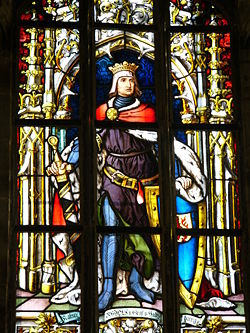
By the late Middle Ages, the Habsburgs, Wittelsbachs, and Luxembourgs struggled for the imperial crown. The Great Interregnum ended in 1273, with the selection of Rudolf of Habsburg,(1218-1291) a minor Swabian prince who made the Habsburgs one of the great powers in the empire. On Rudolf’s death the electors chose Adolf of Nassau (1255-1298), followed by Albert of Austria, then by Henry, Count of Luxembourg (1275-1313), who crossed the Alps in 1310 and temporarily subdued Lombardy. The Roman people crowned him, because the popes had left Rome and were living in Avignon, France, in the Avignon Papacy, the period from 1309 to 1377, during which seven French pope resided in Avignon.
Papal confirmation not required
Civil war raged until the Wittelsbach candidate, Louis IV the Bavarian (1282-1347), defeated his Habsburg rival at the Battle of Mühldorf in 1322. The failure of negotiations between Emperor Louis IV with the papacy led in 1338 to the declaration at Rhense by six electors to the effect that election by all or the majority of the electors automatically conferred the royal title and rule over the empire, without papal confirmation. Between 1346 and 1378 Emperor Charles IV of Luxembourg, king of Bohemia, sought to restore the imperial authority. Around 1350 Germany and almost the whole of Europe were ravaged by the Black Death.
The Golden Bull
Pope Clement VI (1291-1351) opened negotiations with Charles IV, King of Bohemia (1316-1378), who was chosen in 1347. Charles IV, of the House of Luxemborg, ignored the question of papal assent. In the edict of the Golden Bull in 1356, which provided the basic constitution of the empire up to its dissolution, he specified the seven electors, made their lands indivisible, granted them monopolies on mining and tolls, and secured them “gifts” from candidates, making them the strongest princes. Charles entrenched his own dynasty in Bohemia, bought Brandenburg and took Silesia from Poland, and to obtain cash, he encouraged the silver, glass, and paper industries of Bohemia.
The Council of Constance and the Hussites
Sigismund (1368-1437) made Pope John XXIII call the Council of Constance (1414-1418), which ended the Great Schism. But as the King of Bohemia he was chiefly concerned with his own dynastic lands. Bohemia was convulsed by the Hussite movement, which combined Czech nationalism with desire for Church reform. Sigismund invited the Czech religious reformer Jan Hus 1369-1415) to state his views, under imperial protection, at the Council of Constance. But the council subsequently had him burned as a heretic, prompting the inconclusive Hussite Wars (1420-1434) against and among the followers of Hus in Bohemia.
The Habsburgs and German society
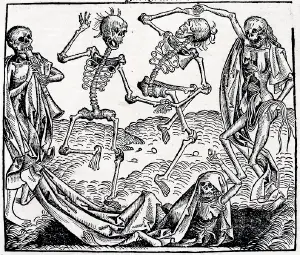
From 1438 the Habsburgs, who controlled most of the southeast of the Empire (more or less modern-day Austria and Slovenia, and Bohemia and Moravia after the death of King Louis II in 1526), maintained a constant grip on the position of the Holy Roman Emperor until 1806. They included Albert II (1397-1439), who died in a civil war in Bohemia and an Ottoman invasion of Hungary, and Frederick III (1415-1493). During his reign from 1493 to 1519, Maximilian I tried to reform the Empire: an Imperial Supreme Court (Reichskammergericht) was established, imperial taxes were levied, the power of the Imperial Diet (Reichstag) was increased. The reforms were, however, frustrated by the continued territorial fragmentation of the Empire. This situation, however, gave rise to increased disunity among the Holy Roman Empires territorial rulers and prevented sections of the country from coming together and forming nations in the manner of France and England.
After the disasters of the fourteenth century, early-modern European society gradually came into being as a result of economic, religious and political changes. A money economy arose which provoked social discontent among knights and peasants. Gradually, a proto-capitalistic system evolved out of feudalism. The Fugger family gained prominence through commercial and financial activities and became financiers to both ecclesiastical and secular rulers. The knightly classes found their monopoly on arms and military skill undermined by the introduction of mercenary armies and foot soldiers. Predatory activity by "robber knights" became common. The plague that swept Europe in the mid-fourteenth century killed about one-third of the population.
Luther and the Protestant Reformation
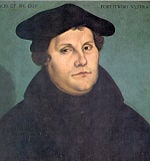
Martin Luther (1483–1546) a German monk, theologian, and church reformer, was particularly aroused by an unscrupulous campaign by the Church to sell indulgences, or remissions of punishment for sin. In 1517, Luther published a list of 95 theses attacking indulgences. In 1520, he published his beliefs, which affirmed the liberty of the Christian conscience informed only by the Bible, a priesthood of all believers, and a State-supported Church. Pope Leo X (1475-1521) condemning Luther’s works, and when Luther burned the papal condemnation, he was excommunicated. Charles V (1500-1558), who became Holy Roman Emperor in 1519, summoned Luther to defend himself at the Diet of Worms (1521). Luther refused to recant, so was outlawed. Hiding in the Wartburg Castle, Luther translated the Bible, establishing the basis of modern German.
Luther's ideas spread rapidly. The fanatical Andreas Karlstadt (1486-1541), a Christian theologian, urged iconoclastic attacks on church painting, statuary, and stained glass. The Peasants' War (1524-1526) broke out in Swabia, Franconia, and Thuringia against ruling princes and lords, following the preachings of Reformist priests. But the revolts, which were assisted by war-experienced noblemen like Götz von Berlichingen and Florian Geyer (in Franconia), and by the theologian Thomas Münzer (in Thuringia), were soon repressed by the territorial princes. The peasants lost all rights, and sense of initiative, and princes set up state Churches in which the service was in German, and the clergy were allowed to marry.
Besides followers of Luther, Protestants were divided between Reformed Christians following Swiss theologian Ulrich Zwingli (1484-1531), who wanted to set up Bible-based theocratic states, and radical Anabaptists, poor people who wanted churches independent of the state. Without peaceful compromise, Charles V routed the Protestant princes and cities at the Battle of Mühlberg in 1547. But many nobles had acquired Catholic lands and were staunch Protestants, so forced on Charles the Peace of Augsburg in 1555, which recognized the Lutheran faith, and stipulated that the religion of a state was to be that of its ruler.
The Catholic counter-reformation
The Council of Trent (1545-1563) abolished the sale of indulgences and reformulated doctrine and worship to preclude reconciliation with Protestantism. The Jesuit order, founded by the Spaniard Ignatius of Loyola (1491-1556), set up centres in German cities, and the rulers of Bavaria, Austria, Salzburg, Bamberg, and Würzburg restored Catholicism by force, creating a Catholic bloc in southern Germany. Protestant princes under Frederick IV (1574-1610) formed the Protestant Union in 1608, while in 1609, Maximilian I, Duke of Bavaria, led the Catholic princes into the Catholic League.
The Thirty Years War
The Thirty Years' War' was fought between 1618 and 1648, principally on the territory of today's Germany, and involved most of the major European continental powers. Although it was ostensibly a religious conflict between Protestants and Catholics, the rivalry between the Habsburg dynasty and other powers was a more central motive, as shown by the fact that Catholic France under the de facto rule of Cardinal Richelieu supported the Protestant side in order to weaken the Habsburgs, thereby furthering France's position as the pre-eminent European power. This increased the France-Habsburg rivalry which led later to direct war between France and Spain.
The impact of the Thirty Years' War, in which mercenary armies were extensively used, was the devastation of entire regions scavenged bare by the foraging armies. Episodes of widespread famine and disease (a starving body has little resistance to illnesses) devastated the population of the German states and, to a lesser extent, the Low Countries and Italy, while bankrupting many of the powers involved. The war may have lasted for 30 years, but the conflicts that triggered it continued unresolved for a much longer time.
The war ended with the Treaty of Mnster, a part of the wider Peace of Westphalia in 1648. The treaty recognized the independence of each Holy Roman Empire state, making the Holy Roman Emperor powerless. The prince of each German state would determine its religion, meaning that Habsburg lands and those the south and west were Catholic. The treaty recognized the Reformed faith, and agreed Protestants could retain acquired lands. But Germany had lost about one-third of its population to war, famine, and plague, as well as much of its livestock, capital, and trade. Refugees and mercenaries roamed, seizing what they could.
The rise of Prussia
From 1640, Brandenburg-Prussia had started to rise under the Great Elector of the House of Hohenzollern, Frederick William (1620-1688). The Peace of Westphalia in 1648 strengthened it even further, through the acquisition of East Pomerania. A system of rule based on absolutism was established. In 1701, Elector Frederick of Brandenburg was crowned "King in Prussia". From 1713 to 1740, King Frederick William I, also known as the "Soldier King", established a highly centralized state.
Meanwhile, the Wettins of Saxony became kings of Poland. The Welfs of Brunswick-Lüneburg gained great influence when Elector George inherited the throne of England as George I in 1714. The Wittelsbachs of Bavaria sought a crown in the Spanish Netherlands, and the Habsburgs of Austria, held Bohemia and Hungary.
The princes became involved in four wars with France — the War of the Devolution (1667-1668), the Dutch War (1672-1678), the War of the League of Augsburg (1688-1697), which won Great Elector Frederick William of Brandenburg Strasbourg and Alsace, and the War of the Spanish Succession (1701-1714), which ended in the Peace of Utrecht. The German princes came into conflict with Sweden in the Baltic, in the First Northern War (1655-1660), and the Great Northern War (1700-1721).
In 1683, the Turks were defeated outside Vienna by a Polish relief army led by King Jan Sobieski of Poland while the city itself was defended by Imperial and Austrian troops under the command of Charles IV, Duke of Lorraine. Hungary was reconquered, and later became a new destination for German settlers. Austria, under the Habsburgs, developed into a great power.
In the War of Austrian Succession (1740-1748) Maria Theresa fought successfully for recognition of her succession to the throne. But in the Silesian Wars and in the Seven Years' War she had to cede Silesia to Frederick II, the Great, of Prussia. After the Peace of Hubertsburg in 1763 between Austria, Prussia and Saxony, Prussia became a European great power. This gave the start to the rivalry between Prussia and Austria for the leadership of Germany.
From 1763, against resistance from the nobility and citizenry, an "enlightened absolutism" was established in Prussia and Austria, according to which the ruler was to be "the first servant of the state". The economy developed and legal reforms were undertaken, including the abolition of torture and the improvement in the status of Jews; the emancipation of the peasants began. Education was promoted.
In 1772-1795 Prussia took part in the partitions of Poland, occupying western territories of Polish-Lithuanian Commonwealth, which led to centuries of Polish resistance against German rule and persecution.
The French Revolution
The French Revolution sparked a new war between France and several of its Eastern neighbors, including Prussia and Austria. Following the Peace of Basel in 1795 with Prussia, the left bank of the Rhine was ceded to France.
Napoleon I of France relaunched the war against the Empire. In 1803, under the "Reichsdeputationshauptschluss" (a resolution of a committee of the Imperial Diet meeting in Regensburg), he abolished almost all the ecclesiastical and the smaller secular states and most of the imperial free cities. New medium-sized states were established in south-western Germany. In turn, Prussia gained territory in north-western Germany.
Holy Roman Empire dissolved
The Holy Roman Empire was formally dissolved on 6 August 1806 when the last Holy Roman Emperor Francis II (from 1804, Emperor Francis I of Austria) resigned. Francis II's family continued to be called Austrian emperors until 1918. In 1806 the Confederation of the Rhine was established under Napoleon's protection.
After the Prussian army was defeated by the French revolutionary forces at Jena and Auerstedt, the Peace of Tilsit was signed in 1807: Prussia ceded all its possessions west of the Elbe to France and the kingdom of Westphalia was established under Napoleon's brother Jérome. Some of the territories Prussia conquered from Poland were regained by Duchy of Warsaw.
From 1808 to 1812 Prussia was reconstructed, and a series of reforms were enacted by Freiherr vom Stein and Freiherr von Hardenberg, including the regulation of municipal government, the liberation of the peasants and the emancipation of the Jews. A reform of the army was undertaken by the Prussian generals Gerhard von Scharnhorst and August von Gneisenau.
In 1813 the Wars of Liberation began, following the destruction of Napoleon's army in Russia (1812). After the Battle of the Nations at Leipzig, Germany was liberated from French rule. The Confederation of the Rhine was dissolved.
In 1815 Napoleon was finally defeated at Waterloo by the Britain's Duke of Wellington and by Prussia's Gebhard Leberecht von Blücher.
Restoration and revolution (1814-71)
Following Napoleon's fall and the end of the Confederation of the Rhine, the Congress of Vienna convened in 1814 in order to restructure Europe. In Germany, the German Confederation was founded, a loose league of 39 sovereign states. Disagreement with the restoration politics partly led to the lifestyle called Biedermeier and to intellectual liberal movements, which demanded unity and freedom during the Vormärz epoch, each followed by a measure of Metternich's repression of liberal agitation. The Zollverein, a tariff union, profoundly furthered economic unity in the German states.
The German people had been stirred by the ideals of the French revolution. On October 18, 1817, students held a gathering to exchange ideas, the high point of which was the burning of works by authors like August von Kotzebue, who were against a united German state. A second such meeting attracted 30,000 people from all social classes and from all regions to the Hambacher celebration. There for the first time, the colours of black, red and gold were chosen to represent the movement, which later became the national colours.
The states were also shaped by the Industrial Revolution, which was the initial step of the growing industrialisation in Europe and contributed to a wave of poverty, causing social uprisings. In light of a series of revolutionary movements in Europe, which in France successfully established a republic, intellectuals and common people started the Revolutions of 1848 in the German states. The monarchs initially yielded to the revolutionaries' liberal demands, and an intellectual National Assembly was elected to draw up a constitution for the new Germany, completed in 1849. However, the Prussian king Frederick William IV, who was offered the title of Emperor but with a loss of power, rejected the crown and the constitution. This prompted the demise of the national assembly along with most of the changes from the revolution.
In 1862, conflict between the Prussian King Wilhelm I and the increasingly liberal parliament erupted over military reforms. The king appointed Otto von Bismarck the new Prime Minister of Prussia. Bismarck solved the conflict with difficulty and used the desire for national unification to further the interests of the Prussian monarchy. In 1864 he successfully waged war on Denmark. Prussian victory in the Austro-Prussian War of 1866 enabled him to create the North German Confederation and divide Austria, formerly the leading state of Germany, from the more western and northern parts.
Second German Empire (1871-1918)
After the French defeat in the Franco-Prussian War, the German Empire (Deutsches Kaiserreich) was proclaimed in Versailles on January 18 1871. As a result, the new empire was a unification of all the scattered parts of Germany but without Austria — Kleindeutschland. Beginning in 1884 Germany established several colonies. The young emperor's foreign policy was opposed to that of Bismarck, who had established a system of alliances in the era called Gründerzeit, securing Germany's position as a great nation, isolating France with diplomatic means and avoiding war for decades. Under Wilhelm II, however, Germany took an imperialistic course, not unlike other powers, but it led to friction with neighbouring countries. Most alliances in which Germany had been previously involved were not renewed, and new alliances excluded the country. Specifically, France established new relations by signing the Entente Cordiale with the United Kingdom, and got ties with Russia. Austria-Hungary and Germany became increasingly isolated.
Although not one of the main causes, the assassination of Austria's crown prince triggered World War I on July 28 1914, which saw Germany as part of the unsuccessful Central Powers in the second-bloodiest conflict of all time against the Allied Powers. In November 1918, the second German Revolution broke out, and Emperor Wilhelm II and all German ruling princes abdicated. An armistice was signed on November 11, putting an end to the war. Germany was forced to sign the Treaty of Versailles in 1919, whose unexpectedly high demands were perceived as humiliating in Germany, as a continuation of the war by other means and a breaking of traditional post-war diplomacy that included negotiations between the victors and vanquished.
Weimar Republic (1919-33)
After the German Revolution in November 1918, a Republic was proclaimed. That year, the German Communist Party was established by Rosa Luxemburg and Karl Liebknecht, and in January 1919 the German Workers Party, later known as the Nationalsozialistische Deutsche Arbeiterpartei (National Socialist German Workers Party, NSDAP, "Nazis"). On August 11 1919, the Weimar Constitution came into effect, with the sign of the Reichspräsident Friedrich Ebert.
In a cool climate of economic hardship from both the world wide Depression and the harsh peace conditions dictated by the Treaty of Versailles, and a long succession of more or less unstable governments, the political masses in Germany increasingly lacked identification with their political system of parliamentary democracy. This was exacerbated by a wide-spread right-wing (monarchist, völkische, and Nazi) Dolchstoßlegende, a political myth which claimed the German Revolution was the main reason why Germany had lost WWI. On the other hand, radical left-wing communists such as the Spartacist League had wanted to abolish what they perceived as a "capitalist rule" in favour of a "Räterepublik" and were thus also in opposition to the existing form of government. During the years following the Revolution, German voters increasingly supported anti-democratic parties, both right- (monarchists, Nazis) and left-wing (Communists). At the beginning of the 1930s, Germany was not far from a civil war. Paramilitary troops were set up by several parties, there were thousands of politically motivated murders. They intimidated voters and seeded violence and anger among the public, who suffered from high unemployment and poverty. After a succession of unsuccessful cabinets, on January 29 1933, President von Hindenburg, seeing little alternative and pushed by advisors, appointed Adolf Hitler Chancellor of Germany.
Third Reich (1933–45)
On 27 February 1933, the Reichstag was set on fire. Some basic democratic rights were quickly abrogated afterwards under an emergency decree. An Enabling Act gave Hitler's government full legislative power — only the Sozial Demokratische Partei, SPD voted against it; the communists could not because many had already been imprisoned or murdered. A centralised totalitarian state was established by a series of moves and decrees making Germany a single-party state. Industry was closely regulated with quotas and requirements in order to shift the economy towards a war production base. In 1936, German troops entered the demilitarised Rhineland and British Prime Minister Neville Chamberlain's appeasement policies proved inadequate. Emboldened, Hitler followed from 1938 onwards a policy of expansionism to establish Greater Germany. To avoid a two-front war, Hitler concluded the Molotov-Ribbentrop Pact with the Soviet Union, and broke it.
In 1939 the growing tensions from nationalism, militarism, and territorial issues led to the Germans launching a blitzkrieg on September 1st against Poland, followed two days later by declarations of war by Britain and France, marking the beginning of World War II. Germany quickly gained direct or indirect control of the majority of Europe. On June 22, 1941, Hitler broke the pact with the Soviet Union by opening the Eastern Front and invading the Soviet Union. Shortly after Japan attacked the American base at Pearl Harbor, Germany declared war on the United States. Although initially the German army rapidly advanced into the surprised Soviet Union, the Battle of Stalingrad marked a major turning point in the war. Subsequently, the German army commenced retreating on the Eastern front, followed by the eventual defeat of Germany. On 8 May 1945, Germany surrendered after the Red Army occupied Berlin.
In what later became known as The Holocaust, the Third Reich regime enacted governmental policies directly subjugating many parts of society: Jews, Slavs, Roma, homosexuals, freemasons, political dissidents, priests, preachers, religious opponents, and the disabled, amongst others. During the Nazi era about 11 million people were murdered in the Holocaust, including more than 6 million Jews.
Division and reunification (1945-90)
The war resulted in the death of several million German soldiers and civilians, in total nearly ten million, large territorial losses and the expulsion of about 15 million Germans of the eastern provinces of Germany and various parts of Central and Eastern Europe with ethnic German population. All major and many smaller German cities lay in ruins. Germany and Berlin were occupied and partitioned by the Allies into four military occupation zones controlled by France, the United Kingdom, the United States, and the Soviet Union. On May 23 1949, the U.S, Britain and France united their individual sectors to form the democratic nation of the Federal Republic of Germany and on October 7 1949 the Soviet Zone established the German Democratic Republic, In English the two states were known informally as "West Germany" and "East Germany" (with historical eastern Germany having fallen to Poland and the Soviet Union) respectively.
West Germany, established as a liberal parliamentary republic with a "social market economy", was allied with the United States, the UK and France. After the ideological switch in U.S. occupation policy away from economic dismantlement and towards reconstruction, which was heralded by the "Speech of hope" in September of 1946, the country eventually came to enjoy prolonged economic growth beginning in the early 1950's (Wirtschaftswunder). The recovery was largely because of the previously forbidden currency reform of June 1948 and U.S. assistance through the Marshall Plan aid. West Germany joined NATO in 1955 and was a founding member of the European Economic Community in 1958. Across the border, East Germany was at first occupied by and later (May 1955) allied with the USSR. An authoritarian country with a Soviet-style command economy, East Germany soon became the richest, most advanced country in the Warsaw Pact, but many of its citizens looked to the West for political freedoms and economic prosperity. Relations between East Germany and West Germany remained icy until the Western Chancellor Willy Brandt launched a highly controversial approchement policy with the East European communist states (Ostpolitik) in the early 1970s. This led to a form of mutual recognition between East and West Germany.
During the summer of 1989, rapid changes took place in East Germany, which ultimately led to German reunification. Growing numbers of East Germans migrated to West Germany via Hungary and clandestinely through the border separating East from West Germany. The exodus generated demands within East Germany for political change, and mass demonstrations with eventually hundreds of thousands of people in several cities continued to grow. In the face of these events, East German authorities unexpectedly eased the border restrictions in November 1989, allowing East German citizens to travel to the West. This led to the acceleration of the process of reforms in East Germany that ended with German reunification on October 3 1990. Under the terms of the treaty between West and East Germany, Berlin again became the capital of the reunited Germany.
Government and politics
Germany's political system is a framework of a federal parliamentary representative democratic republic, whereby the Chancellor is the head of government, and of a pluriform multi-party system. Executive power is exercised by the government. Federal legislative power is vested in both the government and the two chambers of parliament, Bundestag and Bundesrat. While the Bundestag is elected in direct election the Bundesrat represents the governments of the 16 German States. Since 1949 the party system is dominated by the conservative Christian Democratic Union and the Social Democratic Party of Germany. Smaller parties that have an important role are the liberal Free Democratic Party, that has been in the Bundestag since 1949, as well as the Green Party that has had seats in the parliament since 1983.
The German head of state is the President of Germany, elected by an institution consisting of Bundesrat and Bundestag (called Bundesversammlung which means federal convention). The second highest official in the German order of precedence is the President of the Bundestag elected by the Bundestag itself. He is responsible for the parliaments sessions and the regularity of the institution. The third highest official is the chancellor as the head of government recommended by the President of Germany, elected by the Bundestag and if necessary removed by a constructive motion of no confidence of the Bundestag. Constructive motion meens that the Bundestag has to elect a successor.
The Judiciary of Germany is independent of the executive and the legislature. The political system is laid out in the 1949 constitutional document under approval of the allied forces which wanted to assure among other restrictions that Germany's military forces are restricted exclusively to defence and that a dictatorship could not reoccur. It is known as the Grundgesetz literally Basic Law. It is akin to the American Constitution. Changes in the Grundgesetz require a majority of two thirds of both chambers of the parliament. The Grundgesetz remained in effect with minor amendments after 1990's German Reunification.
Legal system
Germany has a civil or statute law system based ultimately on Roman law with some references to Germanic law. Legislative power is divided between the Federation and the individual federated states. While criminal law and private law have seen codifications on the national level (in the Strafgesetzbuch and the Bürgerliches Gesetzbuch respectively), no such unifying codification exists in administrative law where a lot of the fundamental matters remain in the jurisdiction of the individual federated states. In 1976, with the Verwaltungsverfahrensgesetz (VwVfG), the main form of actions of administration was codified. Most federated states have followed this codification. There are a series of special supreme courts; for civil and criminal cases the highest court of appeal is the Bundesgerichtshof (Federal Court of Justice), located in Karlsruhe. The courtroom style is inquisitorial.
The Federal Constitutional Court (Bundesverfassungsgericht), also located in Karlsruhe, is the German Supreme Court responsible for constitutional matters, with power of judicial review. It acts as the highest legal authority and ensures that legislative and judicial practice conforms to the Constitution. It acts independently of the other state bodies, but cannot act on its own behalf.
Administrative divisions
Germany is divided into 16 states (in German called Länder, singular Land; commonly Bundesländer, singular Bundesland). It is further subdivided into 439 districts (Kreise) and cities (kreisfreie Städte) (2004). There is a list of all Administrative Divisions of Germany.
The ten largest cities in Germany (population as of March 31, 2005):
- Berlin (capital of Germany) with 3,396,990 inhabitants
- Hamburg with 1,744,215 inhabitants
- Munich (in German: München) with 1,397,537 inhabitants
- Cologne (Köln) with 975,907 inhabitants
- Frankfurt am Main with 660,289 inhabitants
- Stuttgart with 591,548 inhabitants
- Dortmund with 588,680 inhabitants
- Essen with 588,084 inhabitants
- Düsseldorf with 578,821 inhabitants
- Bremen with 546,932 inhabitants
The five largest metropolitan areas in Germany (population as of January 1, 2005) are listed below. Metro area populations are always controversial, and these figures are based on a broad interpretation of the term. They are better seen as being for metropolitan regions than metropolitan cities.
- Rhein-Ruhr with 11,785,196 inhabitants
- Frankfurt Rhein-Main Region with 5,822,383 inhabitants
- Berlin with 4,262,480 inhabitants
- Hamburg with 3,278,635 inhabitants
- Stuttgart with 2,344,989 inhabitants
| In English | Auf Deutsch (In German) | |||
|---|---|---|---|---|
| State | Capital | Land | Hauptstadt | |
| 1 | Baden-Württemberg | Stuttgart | Baden-Württemberg | Stuttgart |
| 2 | (Free State of) Bavaria | Munich | (Freistaat) Bayern | München |
| 3 | Berlin | Berlin | Berlin | Berlin |
| 4 | Brandenburg | Potsdam | Brandenburg | Potsdam |
| 5 | (Free Hanseatic City of) Bremen | Bremen | (Freie Hansestadt) Bremen | Bremen |
| 6 | (Free and Hanseatic City of) Hamburg | Hamburg | (Freie und Hansestadt) Hamburg | Hamburg |
| 7 | Hesse | Wiesbaden | Hessen | Wiesbaden |
| 8 | Mecklenburg-Western Pomerania | Schwerin | Mecklenburg-Vorpommern | Schwerin |
| 9 | Lower Saxony | Hanover | Niedersachsen | Hannover |
| 10 | North Rhine-Westphalia | Düsseldorf | Nordrhein-Westfalen | Düsseldorf |
| 11 | Rhineland-Palatinate | Mainz | Rheinland-Pfalz | Mainz |
| 12 | Saarland | Saarbrücken | Saarland | Saarbrücken |
| 13 | (Free State of) Saxony | Dresden | (Freistaat) Sachsen | Dresden |
| 14 | Saxony-Anhalt | Magdeburg | Sachsen-Anhalt | Magdeburg |
| 15 | Schleswig-Holstein | Kiel | Schleswig-Holstein | Kiel |
| 16 | (Free State of) Thuringia | Erfurt | (Freistaat) Thüringen | Erfurt |
Foreign relations
Since reunification Germany has resumed its role as a major centre country between Scandinavia in the north and the Mediterranean region in the south, as well as between the Atlantic west and the countries of Central and Eastern Europe.
Germany plays a leading role in the European Union, having a strong alliance with France. Germany is at the forefront of European states seeking to advance the creation of a more unified and capable European political, defence and security apparatus.
Since its establishment on May 23, 1949, the Federal Republic of Germany kept a notably low profile in international relations, because of both its recent history and its occupation by foreign powers. In 1999, however, on the occasion of the NATO war against Yugoslavia, Chancellor Gerhard Schröder's government broke convention by sending German troops into combat for the first time since World War II.
Germany and the United States have been close allies since the end of the Second World War. The Marshall Plan and continued US support during the rebuilding process after World War II, as well as the significant influence American culture has had on German culture, have crafted a strong bond between Germany and the US that lasts to this day. Not only do the United States and Germany share many cultural similarities: they are also deeply economically interdependent. Of all German exports, 8.8% are US-bound, and US–German trade in 2004 totalled $108.2 billion. An illustration of the strong economic relations between the US and Germany may be the fact that 18.3% of all cars sold in the US were manufactured by German car makers. Other signs of the close ties between Germany and the US are the continuing status German-Americans as the largest ethnic group in the US and the status of Ramstein Air Base, close to the city of Kaiserslautern, Germany, as the largest US community outside the US.
Armed forces
Germany's military, the Bundeswehr, is a defence force with Heer (German Army), Marine (German Navy), Luftwaffe (German Air Force), Zentraler Sanitätsdienst (Central Medical Services) and Streitkräftebasis (Joint Service Support Command) branches. It employs some 250,000 soldiers (including women in active fighting branches since 2001) and 120,000 civilians (will be reduced to 75,000). 40,000 of the soldiers are 18–23-year-old men on national duty, currently for at least 9 months. In peacetime, the Bundeswehr is commanded by the Minister of Defence, currently Franz Josef Jung. If Germany goes to war, which according to the constitution is allowed only for defensive purposes, the Chancellor becomes commander in chief of the German Bundeswehr.
Currently, the German military has about 1,180 troops stationed in Bosnia-Herzegovina; 2,650 Bundeswehr soldiers are serving in Kosovo; 780 soldiers are stationed as a part of EUFOR in the Democratic Republic of the Congo; 2,400 soldiers are serving in a navy battle group off the coast of the Lebanon as a part of UNIFIL and 3,900 Bundeswehr troops are assisting the US anti-terrorism operation called Enduring Freedom off the Horn of Africa. 4,500 German troops currently make up the largest contingent of the NATO-led ISAF force in Afghanistan.
Energy policy
In 2000, the German SPD-led government along with Bündnis 90/Die Grünen (Alliance '90/The Greens), officially announced its intention to phase out the use of nuclear energy. Jürgen Trittin as the Minister of Environment, Nature Conservation and Nuclear Safety, reached an agreement with energy companies on limiting the life span of the existing nuclear power plants and an end to the civil usage of nuclear power by 2020. See also: the country's nineteen nuclear power plants
In 1999, electricity production in Germany was powered by coal (47%), nuclear power (30%), natural gas (14%), renewable sources (including hydro, wind and solar power) (6%), and oil (2%) ([5]). As for energy consumption, oil accounted for 41% of the total. At the World climate conference, the German government announced a carbon dioxide reduction target of 25% by the year 2005 as compared to 1990, to protect global climate.[1] Note however, that the 1990 numbers included former industrial facilities in eastern Germany, most of which soon expired in post-1990-Germany.
In 2005, the German government reached an agreement with Russia in building a gas pipeline along the bottom of the Baltic Sea directly from Russia to Germany. Bypassing Poland and other Baltic countries lead to controversy.
Due in part to generous subsidies Germany leads Europe by having the greatest capacity on the continent to generate electricity from sun and wind.[2] In terms of total installed capacity to generate electricity from windpower Germany is No.1 in the world. By 2005 it had a capability to generate 18,427.5 MW (in comparison: 2nd place Spain — 10,027 MW; 3rd place; USA — 9,141 MW). Because of the whims of wind and sun and the reluctance of the conventional energy companies to transmit renewable energy on their transmission lines the power actually generated seldom reaches the capacity to produce it. Since the environmentalistists have been voted out of government and the end of subsidies in 2006 the number of new wind generators to be installed in Germany has dropped dramatically. However, Germany's emphasis on renewable energy sources has resulted in the founding of numerous high-tech companies developing such technologies. Germany is also the main exporter of wind turbines, the demand greatly exceeding capacity.[3]
Economy
Germany is the largest European economy and the third largest economy in the world in real terms, placed behind the United States and Japan, and fifth behind the United States, the People's Republic of China, India and Japan counted by purchasing power parity. According to the World Trade Organization, Germany is also the world's top exporter, ahead of the United States and number two in imports. It currently (2005) has the largest trade surplus in the world (160.6 billion euros). While it has positive trade balances with most of its EU-partners (+129.8 billion euros / 2005) and the United States (+28 billion euros / 2005), it runs trade deficits with China (-18.6 billion euros / 2005), Japan (-8.1 billion euros /2005) and Russia (-4.3 billion euros / 2005). With a net international investment position of 545.9 billion euros (US$682 billion) in Q2 2006 (Deutsche Bundesbank), Germany is the second largest international creditor behind Japan.
A major issue of concern remains the persistently high unemployment rate and weak domestic demand which slows down economic growth. Eastern Germany in particular suffers from a lack of a solid base of small and medium-sized companies, which provided the foundation for the Federal Republic's economic prosperity and is responsible in great measure for Germany's lag in economic growth. In spite of its extremely good performance in international trade domestic demand has stagnated for many years because of wage stagnation and zealous cost-cutting by the federal state. Insecurity among consumers has caused many of the prevalent economic problems. Germany's government runs a restrictive fiscal policy and has cut numerous regular jobs in the public sector. Since reunification there has been a net loss of estimated one million such jobs. But while regular employment in the public sector shrank, "irregular" government employment such as "one-euro jobs" (jobs paid this amount per hour on top of unemployment benefits), government supported self-employment (known informally as "Ich-AG", or "Me, Inc.") and job training increased. Despite the tense situation in eastern Germany, total government employment in Germany remains lower than in other states such as the United Kingdom or Canada.
Economical and political discussion in Germany today concentrates on whether Germany needs more market reforms such as deregulation of the labour market, more low income jobs, lower social security contributions, lower taxes for enterprises and employers, or already passed too many reforms. In view of problematic socio-economic trends (fast growing inequality, rising poverty rates, stagnant wages, less social security, constant high unemployment) corporate profits and salaries of top managers soar. More and more people in Germany distrust the sense and direction of the reforms over the last years. A major reason is the pressure that unions and lobbyists exert on parliament. One third of the lower house (Bundestag) are themselves in one union or another. Many representatives of the upper house (Bundesrat) and lower house are at the same time on the advisory council (Aufsichtsrat) of major concerns in the pharmaceutical, energy and automobile sectors leading to exploding costs for the consumer in these areas.
See also below: Science and technology
Exports
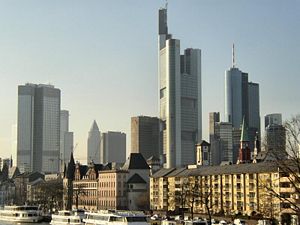
As mentioned above the export of goods is an essential part of the German economy and one of the most relevant reasons for Germany's wealth. Like many other export oriented countries, Germany itself does not have the climate or the natural resources necessary to support a high living standard. Overtaking the United States in 2003, Germany is now the world's largest exporter of goods with $1.016 trillion exported in 2005 (Germany's exports to other euro zone countries are included in this total). In export of services (tourism, financial services, engineering...) it ranks third behind the United States and the United Kingdom. Altogether it's the second largest exporter behind the United States.
Although most of its exports are in engineering (such as cars, machinery, chemical goods, and optics), Germany also has a strong position in the export of microelectronics, which, according to the WTO, account for 15 percent of German exports. Germany sells nearly twice as many such products per capita than the United States, significantly more than Japan and nearly the same as the United Kingdom.
Transport
Because of Germany's central situation in Europe, the volume of traffic, especially goods transit, is very high. In the past decades, much of the freight traffic shifted from rail to road transport, which led the Federal Government to introduce a motor toll for trucks in 2005. In addition, individual traffic increased to an extent that on German roads, traffic densities are very high by international comparison. For the future, a further strong increase of traffic is expected.
High-speed vehicular traffic has a long tradition in Germany, not only owing to the automobile industry, but also, because the first motorway (Autobahn) in the world, the AVUS, and the world's first automobile were developed and built by Carl Benz in Germany. Germany possesses one of the densest road systems of the world. It covers 12,037 kilometres (7,479 mi) of federal "Autobahn" motorways and 41,386 kilometres (25,716 mi) of federal highways. In contrast to other European countries, German motorways partially have no blanket speed limit. However, signposted limits are in place on many dangerous or congested stretches, and where traffic noise or pollution poses a nuisance; some of these limits apply only at night or only in wet conditions.
Another way to travel is via rail. Deutsche Bahn (German Rail) is the major German railway infrastructure and service operator. For commuter and regional services, franchises of various sizes are granted by the individual states, though largely financed from the federal budget. Unsubsidised long-range service operators can compete freely all over the country, at least in theory. Actually, Deutsche Bahn holds a de facto monopoly on long-range services.
The InterCity Express or ICE is a type of high-speed train operated by Deutsche Bahn in Germany and neighbouring countries, for example to Zürich, Switzerland or Vienna, Austria. ICE trains also serve Amsterdam (The Netherlands) as well as Liège and Brussels (Belgium). In spite of branch lines progressively being closed for at least the last seven decades, the rail network throughout Germany is still very extensive and provides excellent services in most areas. On regular lines, at least one train every two hours will call even in the smallest of villages. Nearly all larger metropolitan areas are served by an S-Bahn heavy rail metro system. A large proportion of towns feature underground and/or tram systems. Good urban and overland bus services are ubiquitous.
Frankfurt International Airport is a major international airport and European transportation hub. Frankfurt Airport ranks among the world's top ten airports and serves 304 flight destinations in 110 countries. Depending whether total passengers, flights or cargo traffic are used as a measure, it ranks as the busiest, second busiest and third busiest in Europe. alongside London Heathrow Airport and Paris's Charles de Gaulle.
Germany's second important international airport is Munich International Airport; other major airports are Düsseldorf International Airport, Berlin, Hamburg Airport and Cologne Bonn Airport. Travelling by plane within Germany is unusual due to the extensive network of motorways and railway services.
Demographics

As of December 2004, about 7 million foreign citizens are registered in Germany and 19% of the country's residents are of foreign or partially foreign descent, the majority are Turkish, or are from Italy, Yugoslavia, and other European states.[4] In its State of World Population 2006 report, the United Nations Population Fund lists Germany with hosting the third-highest percentage of international migrants worldwide, about 5% or 10 million of all 191 million migrants.[5]
Because of modifications to Germany's traditionally rather unrestricted laws on asylum and immigration in the years around 2000, the number of annual asylum seekers as well as on immigrants based on German ethnicity (mostly from the former Soviet Union) has been declining since then.
Germany faces major demographic change, as its birth rate being one of the lowest in the world. The federal statistics office estimates the population will shrink to approximately 75 million by 2050, with ethnic Germans risking displacement by foreigners with higher birthrates. Questions remain as to how Germany will pay for the sustenance of immigrants, in addition to its own aging population.[6] Chemnitz is thought to be city with the lowest birth rate in the world.[7]
There are 2.2 million Turks in Germany, 139,000 of them in Berlin alone, making them the largest group of foreign workers.
Population
Ethnicity
Religion
Germany is the home of the Reformation launched by Martin Luther in the early 16th century. Today, Protestants (particularly in the north and east) comprise about 33% of the population and Roman Catholics (particularly in the south and west) also 33%. The current Roman Catholic Pope, Benedict XVI, was born in Bavaria. In total more than 55 million people officially belong to a Christian denomination.
The third largest religious identity in Germany, after the two Christian groups, is that of non-religious people (including atheists and agnostics (especially in former GDR)), who amount to a total of 28.5% of the population (23.5 million).
Approximately 3 million Muslims [6] (predominantly from Turkey and some from the former Yugoslavia) live in Germany. Most are Sunnis and Alevites from Turkey but there are a small number of Shiites.
Today's Germany has Western Europe's third-largest Jewish population. In 2004, twice as many Jews from former Soviet republics settled in Germany as in Israel, bringing the total influx to more than 200,000 since 1991. About half joined a settled Jewish community, of which there are now more than 100, with a total of 100,000 members — up from 30,000 before reunification. Some German cities have seen a revival of Jewish culture, particularly in Berlin, where there are also 3,000 Israelis. Jews have a strong voice in German public life through the Zentralrat der Juden in Deutschland (Central Council of Jews in Germany). Other cities with significant Jewish populations are Frankfurt and Munich.
Social issues
The German social market economy (German: soziale Marktwirtschaft) helped bring about the "economic miracle" (the German "Wirtschaftswunder") that rebuilt Germany from rubble after World War II to one of the most impressive economies in Europe. Still today, Ludwig Erhard, minister of economics in the Adenauer administration (1949–1963) and later chancellor (1963–1966), is widely recognised as having been the "father" of this profound rise in the country's economic and social wealth.
Germany continues to struggle with a number of social issues, although problems created by the German Reunification of 1990 have begun to diminish. The standard of living is higher in the western half of the country, but easterners now share a reasonably high standard of living. Germans continue to be concerned about a relatively high level of unemployment, especially in the former East German states. The country has passed several reforms to curb unemployment. Recent polls have indicated a growing poverty in the country. In spring of 2006 it had reached 8% of the population, in the easten part as high as 20% according to the FES (Friedrich-Ebert Stiftung).
For centuries, a woman's role in German society was summed up by the three words: Kinder (children), Küche (kitchen), and Kirche (church) — Kinder, Küche, Kirche. Throughout the twentieth century, however, women have gradually won victories in their quest for equal rights. Despite significant gains, discrimination remains in united Germany. Women are noticeably absent in the top tiers of German business. They only hold 9.2% of jobs in Germany's upper and middle management positions.[8] Until 2001 women were barred from serving in combat units in the Bundeswehr, being restricted to the medical service and the administration. The first woman to become chancellor is Angela Merkel, who was elected in 2005.
Since World War II, Germany has experienced intermittent turmoil from various groups. In the 1970s leftist terrorist organisations like the Red Army Faction engaged in a string of assassinations and kidnappings against political and business figures and there has been a recent surge in right-wing nationalist crimes. According to former Interior Minister Otto Schily, the number of these crimes rose 8.4% to 12,553 cases in 2004, which the minister attributed to such crimes as the display of illegal Nazi symbols being reported more frequently.
As mentioned elsewhere in this article population growth is burdened with an extremely low fertility/birthrate. Currently Germany's average birth rate has plunged to less than 1.4 children per mother, a situation which would lead to the demise of any species if nothing is undertaken to relieve it. Lawmakers ask what the state can do to encourage women to have more children. According to provisional figures from the Federal Statistics Office, 680,000 babies were born in Germany in 2005, down from a peak of 1.36 million in 1964 and fewer even than in 1945, when nearly all the country lay in rubble.
Germany has failed to implement EU laws prohibiting racial discrimination. The European Court of Justice ruled on April 29 2005, that Germany had breached EU law by failing to transpose fully the 'Racial Equality Directive' prohibiting discrimination on the grounds of race or ethnic origin (Directive 2000/43/EC). Immigrants to Germany may generally face integration issues and other difficulties. In addition to the challenges of adapting to a new language and culture, they may be subject to security-related police inquiries and violence from right-wing nationalist groups.
Some German states have banned Muslim teachers from wearing headscarves in class and all except Bavaria have banned crosses from the classroom as well, generally by prohibiting the use of all religious symbols by teachers. This is legitimate by combining the German states' privilege of educational laws with the principle of separation of church and state, both provided for in the German federal constitution: According to this legal view, teachers in their vocational function within a state administered educational system are obliged to maintain and publicly exhibit religious neutrality when on duty. As this status of employment does not hold for pupils, whose constitutional right to religious freedom thus remains unencumbered by these provisions, this ban cannot legally be extended to them as it is in France.
Language
The German language was once the lingua franca of central, eastern and northern Europe. Within the European Union, German is the language with the most native speakers, with more than English, French, Spanish and Italian, because the borders of the German language reach through Austria, Italy, Belgium, Denmark, Luxembourg, the Netherlands and into Switzerland. As a foreign language, German is the third most taught worldwide.[7] It is also the second most used language on the Internet after English. The language has its origin in Old High German which is related to old English. There are numerous dialects of German, many of which are not intelligible to speakers of standard German or a different dialect. Some consider Low German to be a different language from High German; Low German has been given the status of a minority language by the European Union, although it is less used today in the traditionally Low German-speaking areas of northern Germany. Other dialects, which are very different from standard German are spoken in Saxony, Bavaria, Rhineland-Palatinate and Swabia. The Pennsylvania Dutch, spoken by the Amishe is derived from the dialect spoken in the Rhineland-Palatinate.
Men and women
=Marriage and the family
Education
Germany has one of the world's highest levels of education and many famous universities. The most important foreign languages taught at school are English, French, Latin, Italian and Spanish. Some languages, such as Russian, Ancient Greek, Turkish, Chinese, Japanese, Polish and Arabic are taught less widely. Since the end of World War II, the number of youths entering universities has more than tripled, but university attendance still lags behind many other European nations because of its very high standards. In the annual league of top-ranking universities compiled by Shanghai Jiaotong University in 2004, Germany came 4th overall, with 7 universities in the top 100 (to compare, the United States had 51 in the top 100, but a lot of more universities generally, so that the proportional comparison precipates very well). The highest ranking university, at #45, was the TU Munich. Most German universities are state-owned and were free of charge, however a recently passed education reform calls for fees between €300 and €500 per semester from each student, started in 2006 in the first state (Niedersachsen). Additionally university students are often supported by the so called BAföG, a federal subsidy, running as high as €290 per month as interest free credit plus €290 as direct payment.
Germany (along with [[austria] and switzerland) has a special system of apprenticeship called "Duale Ausbildung" in which apprentices learn in a company as well as state-run school.
German educational ideals differ considerably from Anglo-Saxon educational ideals, emphasising socialisation, debate, vocal participation in class and critical faculties. The results of the PISA student assessments, that revealed comprehension of the respective subject matters only, were a shock to the German public but no surprise to many educational experts. In the test of 31 countries in year 2000 Germany ranked 21st in reading and 20th in both Mathematics and in the Natural Sciences.
Participation in the official school system is compulsory; however, home-schooling is still practised by a small number of people. There has been some publicity to government prosecution of this practice.
Class
Culture
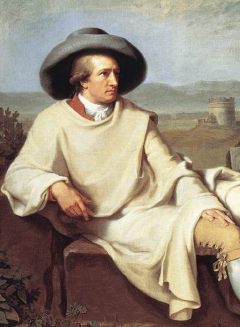
Architecture
Art
Cuisine
Literature
Germany's contributions to the world's cultural heritage are numerous, and the country is often known as das Land der Dichter und Denker (the land of poets and thinkers). German literature can be traced back to the Middle Ages, in particular to such authors as Walther von der Vogelweide and Wolfram von Eschenbach, considered some of the most important poets of medieval Europe. The fairy tales by Jacob and Wilhelm Grimm are world famous and the Nibelungenlied, whose author is not known, is also a major contribution to German literature. The Thidrekssaga with similar sources is more based in the north european area. Theologian Luther, who translated the Bible into German, is widely credited for having set the basis for modern "High German" language. The most admired German poets and authors are Lessing, Goethe, Schiller, Kleist and Hoffmann. Other poets include Friedrich Hölderlin, Heinrich Heine, Annette von Droste-Hülshoff, Theodor Fontane, Rainer Maria Rilke and authors of the 20th century include Nobel Prize winners Thomas Mann, Hermann Hesse, Heinrich Böll and Günter Grass. Other famous authors are Brecht and Schmidt. Germany's influence on world philosophy was significant as well, as exemplified by Magnus, Leibniz, Kant, Herder, Mendelssohn, Novalis, Fichte, Hegel, Marx, Engels, Feuerbach, Schopenhauer, Schweitzer, Nietzsche, Husserl, Hartmann, Jaspers, Luxemburg, Heidegger, Arendt, Steiner, Gadamer and Habermas. In the field of sociology influential German thinkers were Tönnies, Simmel, Weber, Horkheimer, Adorno and Luhmann.
Many historical figures, though not citizens of Germany in the modern sense, were important and influential figures in German culture, such as Wolfgang Amadeus Mozart, Franz Kafka and Stefan Zweig.
Music
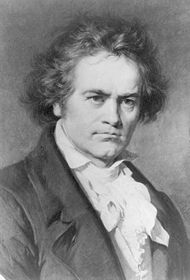
In the field of music, Germany's influence is noted through the works of, among others, Bach, Händel, Telemann, Beethoven, Mendelssohn Bartholdy, Mozart, Brahms, Schumann, Wagner, Strauss, Orff.
Science and technology
Germany is a leading nation in scientific research and the production of innovative technological products. Some of the most important industrial contributions include automobiles, rocketry, material science, and chemical products.
As in physics and chemistry, Germans are a leading nation in the Nobel Prizes for physiology or medicine. In spite of past achievements of their ideals young scientists are currently emigrating at the rate of over 2000 per month (26,000 in 2005). Assumed reasons are overwhelming bureaucracy and a bleak outlook for their future.
Germany has been the homeland of many great scientists like Helmholtz, Fraunhofer, Fahrenheit, Kepler, Haeckel, Wundt, Virchow, Ehrlich, Humboldt, Röntgen, Braun, Einstein, Born, Planck, Heisenberg, Creuzfeldt, Hertz, Koch, Hahn, Leibniz, Liebig, Ostwald, Haber, Mayr and Bunsen.
It has been the home of many inventors and engineers such as Gutenberg, Otto, Geiger, Fick, Lilienthal, Junkers, Reis, von Ardenne, von Mayenburg, Bosch, Bentz, von Drais, Zeppelin, Krupp, Siemens, von Braun, Porsche, Maybach, Daimler, Zuse, Diesel and Benz.
Important mathematicians were born in Germany such as Dedekind, Bessel, Gauß, Hilbert, Jacobi, Riemann, Riese, Klein, Cantor, Weierstraß and Weyl.
With the construction of the first laboratory for psychology at the University of Leipzig in 1879 , Wilhelm Wundt established psychology as an independent empirical science. Important psychologists were born in Germany such as Wundt, von Helmholtz, Charlotte Bühler, Karl Bühler, Heckhausen.
International rankings
For an explanation of the ratings, see the corresponding article.
Political and economic rankings
- Political freedom — Free; political rights and civil liberties both rated 1 (the highest score available)
- Press freedom — 18th freest in the world at 4.00
- GDP per capita (PPP) — 17th highest in the world at I$30,579
- Human Development Index — 20th highest in the world at 0.930
- Income equality — 14th most equal income at 28.3 (Gini index)
- Literacy rate — Equal 1st with 99.9%
- Unemployment rate — 80th lowest with 10.60%
- Corruption — 16th lowest with a rating of 8.2
- Economic freedom — Equal 19th freest with a rating of 1.96
Health rankings
- Fertility rate — 171st most fertile country with a rating of 1.39 per woman
- Birth rate — 192nd most births per capita at 8.33 per 1000 people
- Infant mortality — 11th least infant deaths with a rating of 4.16 per 1000 births
- Death rate — 55th highest with a rating of 10.55 deaths per 1000 people
- Life expectancy — 23rd highest with 78.80 years
- Suicide rate — 28th highest with 20.4 for men, 7.0 for women and 13.5 total
Other rankings
- CO2 emissions per capita — 34th highest with 9.8 metric tons per capita
- Electricity consumption — 7th highest with 510,400,000,000 kWh
- Broadband uptake — 18th highest with 13.0%
- Beer consumption — 3rd largest with 115.8 L per capita
Miscellaneous topics
- Communications in Germany
- East Germany
- Foreign relations of Germany
- German federal election, 2005
- 2006 FIFA World Cup in Germany
- German model
- Historical Eastern Germany
- List of English exonyms for German toponyms
- List of famous Germans
- List of German districts
- List of German towns
- List of Germans — German people
- List of political parties in Germany
- List of universities in Germany
- Major power — Germany
- Names for Germany
- Nuclear power phase-out
- Scouting in Germany
- Security issues in Germany
- Taxation in Germany
- Tourism in Germany
- Transportation in Germany
- West Germany
- German-Japanese relations
- Sino-German cooperation.
- Overview of Germany project pages
ReferencesISBN links support NWE through referral fees
- ↑ ([1], pdf)
- ↑ [2]. This achievement was boosted by the Renewable Energies Act (EEG), introduced on April 1, 2000, aimed at achieving a minimum 12% market share for renewable energy by 2010 (compared to 3.4% in 1990). By 2005 German solar electricity capacity had reached 794 MWp (78.6% of total European capacity) [3], while wind generating capacity had reached 16,629 MWp (48.4% of European capacity) [4]. It is estimated that the renewable industries now employ, directly or indirectly, more than 120,000 people. Germany has committed to a 21% reduction in carbon dioxide emissions from 1990 levels by 2012.
- ↑ Article in Financial Times Deutschland
- ↑ Federal Statistical Office Germany: Foreign population on 31 December 2004 by country of origin
- ↑ United Nations Population Fund: State of World Population 2006
- ↑ Cite error: Invalid
<ref>tag; no text was provided for refs namedp2300022 - ↑ bbc.co.uk
- ↑ Hoppenstedt business databank 2002
External links
- Deutschland.de — Official German portal
- CIA — The World Factbook — Germany
- DW-WORLD.DE Deutsche Welle — Germany's international broadcaster - its media visiting card throughout the world
- News Portal of the German Embassy to the USA
- historical facts about Germany Facts and a quiz about Germany
- Facts about Germany — by the German Federal Foreign Office
- A manual for Germany — by the German Government Representative for Migration, Refugees and Integration
- Destatis.de — Federal Statistical Office Germany (in English)
- Travel to Germany — by Wikitravel.org
- Germany Travel Info — by the German National Tourist Office
- The Germans explained and Take it from a German — Essays about German idiosyncrasies, from Der Spiegel.
Further reading
- Jean Edward Smith, Germany Beyond The Wall: People, Politics, and Prosperity, Boston: Little, Brown, & Company, 1969.
- Jean Edward Smith, Lucius D. Clay: An American Life, New York: Henry, Holt, & Company, 1990.
- Jean Edward Smith, The Defense Of Berlin, Baltimore: Johns Hopkins Press, 1963.
- Jean Edward Smith, The Papers Of Lucius D. Clay, 2 Vols., Bloomington, Indiana: Indiana University Press, 1974.
- George Donaldson, Germany: A Complete History., New York: Gotham Books, 1985.
- Hajo Holborn. A MODERN HISTORY OF GERMANY; Princeton University Press;
- Volume I: The Reformation; 1959/1982; LCC 82-0126
- ISBN 0-691-05357-X (Hardcover).
- ISBN 0-691-00795-0 (Softcover).
- Volume II: 1648–1840; 1964/1982; LCC 82-0126
- ISBN 0-691-05358-8 (Hardcover).
- ISBN 0-691-00796-9 (Softcover).
- Volume III: 1840–1945; 1969/1982; LCC 82-0126
- ISBN 0-691-05359-6 (Hardcover).
- ISBN 0-691-00797-7 (Softcover).
| Preceded by: West Germany Concurrent with: East Germany 1949-1990 |
Government of Germany 1990–Present |
Succeeded by: Current |
| |||||||
| Group of Eight |
|---|
| Canada | France | Germany | Italy | Japan | Russia | United Kingdom | United States |
Template:EU countries and candidates
| North Atlantic Treaty Organisation (NATO) | |
|---|---|
| Belgium | Bulgaria | Canada | Czech Republic | Denmark | Estonia | France | Germany | Greece | Hungary | Iceland | Italy | Latvia | Lithuania | Luxembourg | The Netherlands | Norway | Poland | Portugal | Romania | Slovakia | Slovenia | Spain | Turkey | United Kingdom | United States of America | |
Albania · Andorra · Armenia2 · Austria · Azerbaijan1 · Belarus · Belgium · Bosnia and Herzegovina · Bulgaria · Croatia · Cyprus2 · Czech Republic · Denmark3 · Estonia · Finland · France3 · Georgia1 · Germany · Greece · Hungary · Iceland · Ireland · Italy · Kazakhstan1 · Latvia · Liechtenstein · Lithuania · Luxembourg · Republic of Macedonia · Malta · Moldova · Monaco · Montenegro · Netherlands3 · Norway3 · Poland · Portugal · Romania · Russia1 · San Marino · Serbia · Slovakia · Slovenia · Spain3 · Sweden · Switzerland · Turkey1 · Ukraine · United Kingdom3 · Vatican City
1 Has majority of its territory in Asia. 2 Entirely in Asia but having socio-political connections with Europe. 3 Has dependencies or similar territories outside Europe.
Template:Baltic
Template:North Sea
Template:Germanic Europe
Credits
New World Encyclopedia writers and editors rewrote and completed the Wikipedia article in accordance with New World Encyclopedia standards. This article abides by terms of the Creative Commons CC-by-sa 3.0 License (CC-by-sa), which may be used and disseminated with proper attribution. Credit is due under the terms of this license that can reference both the New World Encyclopedia contributors and the selfless volunteer contributors of the Wikimedia Foundation. To cite this article click here for a list of acceptable citing formats.The history of earlier contributions by wikipedians is accessible to researchers here:
- Germany history
- Geography_of_Germany history
- History_of_Germany history
- Clovis_I history
- Merovingian history
- Carolingian_dynasty history
- Frederick_I_Holy_Roman_Emperor history
- Frederick_II_Holy_Roman_Emperor history
- Thirty_Years_War history
The history of this article since it was imported to New World Encyclopedia:
Note: Some restrictions may apply to use of individual images which are separately licensed.


